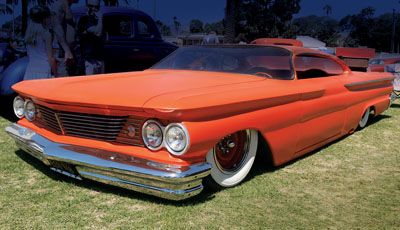
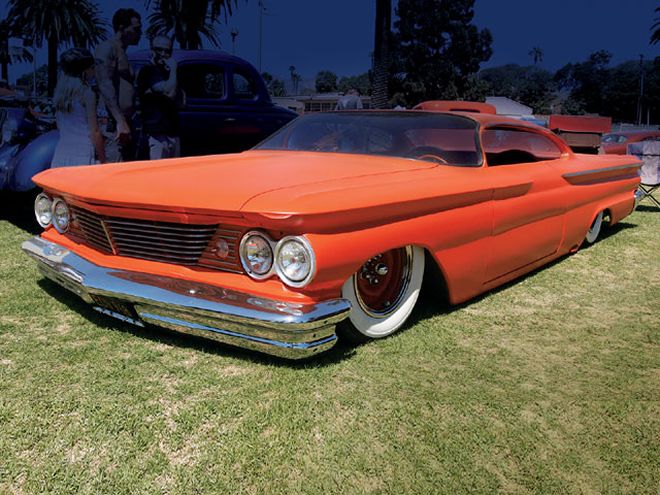 The variety, quality, application, and acceptance of flat finishes have improved a lot in the last 20 years. Kirk Morris' '60 Bonneville custom doesn't seem at all self-conscious about its low-gloss paint.
The variety, quality, application, and acceptance of flat finishes have improved a lot in the last 20 years. Kirk Morris' '60 Bonneville custom doesn't seem at all self-conscious about its low-gloss paint.
There was a time when a flat-finished hot rod would've been regarded as either a work in progress or the victim of an oxidated paintjob. Showing up at a show with a non-glossy ride was the car show equivalent of going to church in your underwear. Nowadays, flat paint is almost expected on traditionally inspired rods and customs. For some rodders, a coat of primer is a quick, easy, low-buck way to get a finish on their cars. For a few, a cheap paintjob is a statement against the extravagant paint on over-the-top show cars (and easier than confessing a lack of money or skill). But, many talented builders are covering their high-buck rides with well-done flat finishes, too.
Although some car shows still enforce a "no flat paint" rule, flat has become a legit alternative to glossy. Goodguys sets up special areas for "Suede & Chrome" cars. The Suede Palace is a popular part of the Grand National Roadster Show. The same goes for the Sacramento Autorama's Suede Pavilion.
As flat paint has been embraced by hot rodders, the quality of these paintjobs has improved-or maybe it's the other way around. But, describing a finish as "flat" is as vague as describing a color as "green." When you talk about levels of flatness, you're really talking about the levels of gloss or reflectivity, which can range from a mirror to a cardboard box. If you had a reflectometer in your toolbox, you could measure your paint's reflectivity and rate it on a scale from zero to 100. Paint industry guys love doing this and have specific terms for the various levels:
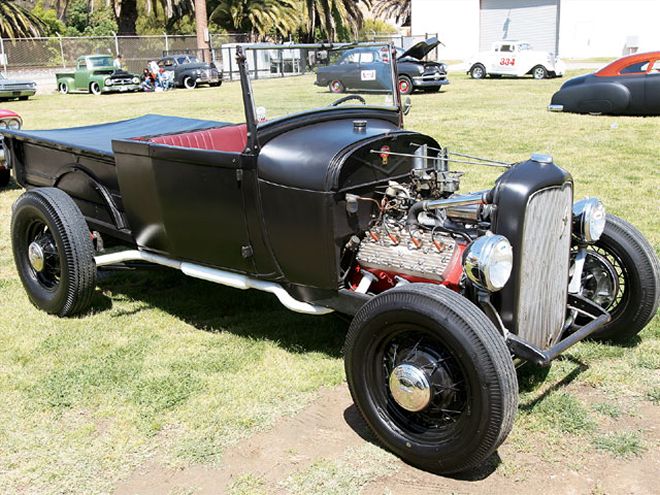 This Model A rpu shows some oxidation and wear along with its workmanship, which perfectly suits its personality. On a low-budget rod, a low-budget non-gloss finish could be achieved with plain old primer, or exposed black basecoat. Either method would require a little maintenance to keep the color from chalking up.
Less than 10 Flat 10-30 Matte 30-50 Satin 50-75 Semigloss 75-{{{90}}} Reduced Sheen More than 90 Full Gloss
This Model A rpu shows some oxidation and wear along with its workmanship, which perfectly suits its personality. On a low-budget rod, a low-budget non-gloss finish could be achieved with plain old primer, or exposed black basecoat. Either method would require a little maintenance to keep the color from chalking up.
Less than 10 Flat 10-30 Matte 30-50 Satin 50-75 Semigloss 75-{{{90}}} Reduced Sheen More than 90 Full Gloss
What level of flatness/gloss do you want? Is it rattle-can primer or a meticulously prepped and sprayed two-stage semigloss job? Once you've decided on a look, how can you achieve it? In past articles, we asked custom painters for advice. This time, we talked to Brian Lynch-training manager for Valspar and House of Kolor-and a few other paint industry pros for the perspective from the product side.
The most basic, and maybe most common, way to get a flat finish is with colored primer. Shooting primer with no topcoat is easy and cheap, and perfectly appropriate for a low-buck rod, but offers little in the way of protection or durability. Those are secondary priorities anyway for some rodders; for others, a coat of primer is a temporary solution until they're ready for a more extensive paintjob.
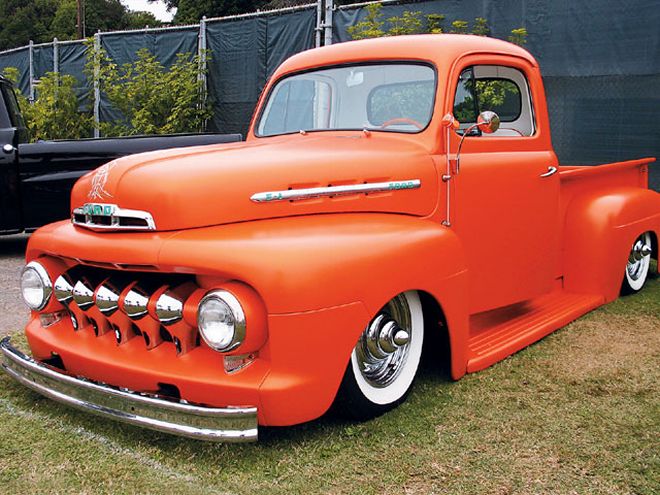 This '51 Ford F-1 is more about fit and finish than the black Model A-and the paintjob was probably as much work as most high-gloss jobs. The level of reflectivity is closer to semigloss than full-on flat. It may have been a full-system job, maybe with a standard basecoat covered with flattened clear.
This '51 Ford F-1 is more about fit and finish than the black Model A-and the paintjob was probably as much work as most high-gloss jobs. The level of reflectivity is closer to semigloss than full-on flat. It may have been a full-system job, maybe with a standard basecoat covered with flattened clear.
Basecoat without a clearcoat is another method for going flat. Polishing would, obviously, defeat the purpose, but sanding with some 1,500- or 2,000-grit sandpaper would contribute to the desired look. Brian pointed out that cool effects can be achieved by color-sanding and polishing some areas while leaving others flat to create a contrast. As with exposed primer, this method has the disadvantage of eliminating the protection of a clearcoat.
At the other end of the spectrum is the full-system job, using primer and colored basecoat and finishing with flattened clear. When shooting a multistage flattened paintjob, Brian prefers to add the flattening agent to the clear instead of to the basecoat, since flattener can affect the paint's color and opacity. Clear does not contain pigments and other solid contents that can be compromised by flatteners.
An intermediate option is to shoot a basecoat, such as a single-stage urethane, that has had the gloss reduced by adding a flattening agent. Flattening agents contain ingredients that, when added to paint or clear, disrupt the clarity of the material, making it easy to get a non-gloss finish in any color you want. In some cases, the flattening ingredient is a wax additive; in other cases, it's an inert physical particulate (silica, for example) that floats on top to prevent reflectivity of an otherwise glossy material.
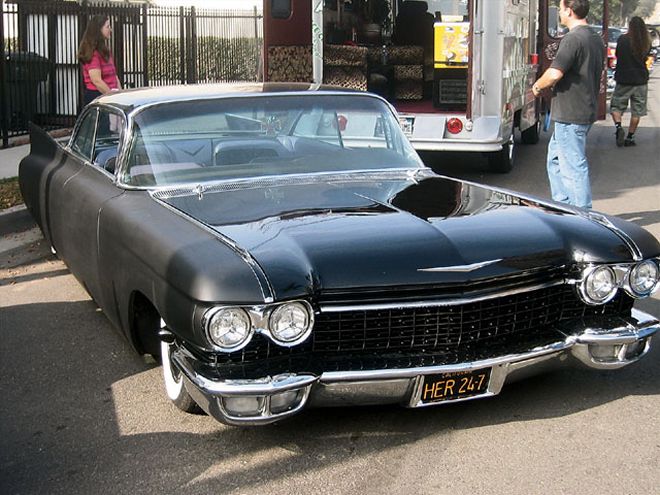 Brian Lynch from Valspar/House of Kolor sent us this photo of a one-color, two-tone '60 Cadillac. After shooting the whole car, the painter polished the hood, top, and decklid, leaving the rest of the paint dull. The concept is so simple-but the effect is wild and could be applied to any hot rod or custom in an infinite number of cool ways.
Brian Lynch from Valspar/House of Kolor sent us this photo of a one-color, two-tone '60 Cadillac. After shooting the whole car, the painter polished the hood, top, and decklid, leaving the rest of the paint dull. The concept is so simple-but the effect is wild and could be applied to any hot rod or custom in an infinite number of cool ways.
Wax-based flatteners have the advantage of less cost, ease of mixing, and familiarity. However, the softer finish presents a greater likelihood of "rub back," especially on parts that are handled frequently, such as decklids. Over time, friction can rub out the flat finish, causing it to become glossy. The inert materials in the silica-type flatteners actually contribute to surface hardness, reducing the possibility of rub back.
As you'd expect, adding more flattener reduces the level of gloss-but higher-quality paints, with more solid content, generally require more flattener to achieve the same level of flatness. According to the Gloss Reduction Table in the Valspar Technical Data Manual, a two-to-one mix of Valspar SunCryl (a lesser-priced single-stage enamel) and FX-01 flattener reduces reflectivity to 11.6, between flat and matte. However, a two-to-one mix of Valspar Omega 2K single-stage polyurethane and FX-01 only drops reflectivity to 92, which is still a full-gloss finish. Clearcoats tend to drop more quickly than high-quality urethane basecoats-which is another argument for adding flattener to the clear instead of to the basecoat.
There is no single definition of a flat finish, but the right combination of colors or levels of gloss can make a stronger impression than shiny paint. It may not be enough to get you through the gate at a "finished-car only" show, but it may be enough to silence those people who can't look at a low-gloss car without asking, "When are you gonna paint it?"
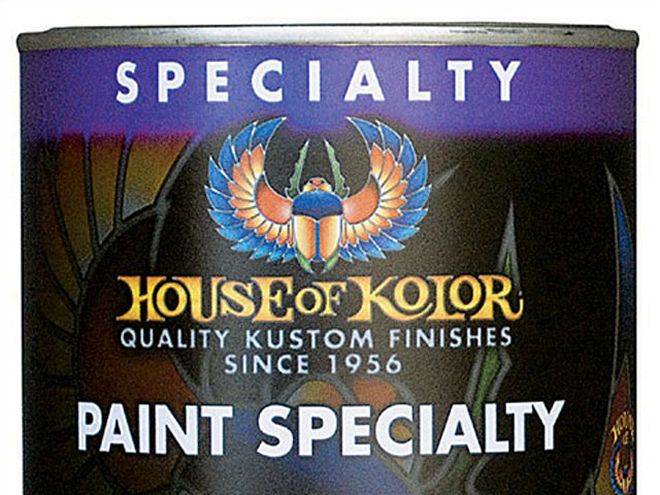 House of Kolor's FA01 Flattening Agent is an inert material-based product designed to provide excellent surface uniformity. The silica floats to the top of the coat to inhibit the glossiness of acrylic lacquer and polyurethane enamel basecoats and clears. The HOK Technical Data Manual provides info on the amount of flattening agent you'll need to achieve the look you want.
House of Kolor's FA01 Flattening Agent is an inert material-based product designed to provide excellent surface uniformity. The silica floats to the top of the coat to inhibit the glossiness of acrylic lacquer and polyurethane enamel basecoats and clears. The HOK Technical Data Manual provides info on the amount of flattening agent you'll need to achieve the look you want.
The Whole Spectrum
Kustom Shop, a division of TCPGlobal, is making it easier to get a high-quality, low-gloss finish in a variety of colors. The Hot Rod Flatz line of pre-flattened urethane paint delivers a 30-degree level (matte to satin) appearance that Joe McGowan at Kustom Shop refers to as an eggshell finish. Joe explained that adding the flattener during manufacturing eliminates the settling that sometimes occurs with basecoat additives. Hot Rod Flatz paint also contains material to protect against UV rays. Ordinary primer or basecoat without clear can get chalky in a matter of months, but these finishes are designed for years of protection.
In addition to the 36 solid colors and 20 metallics and pearls available off the shelf, Kustom Shop can match any OEM paint code. The company's huge auto-color library (check it out on the Web site) goes as far back as 18th century carriage colors. Hot Rod Flatz also offers quick-drying urethane clear for adding a low-gloss finish to any urethane basecoat.
Flat Top
Not many hot rod and custom shops market their own brand of paint products, but Squeeg Jerger needed a primer that wouldn't shrink, crack, or blister under the paint-hating Arizona sun. Squeeg's Kustoms Epoxy Primer Filler is based on a product originally made for heavy-duty industrial applications like bridges and water towers. Doug Jerger told us it is similar to the popular PPG DP90 epoxy.
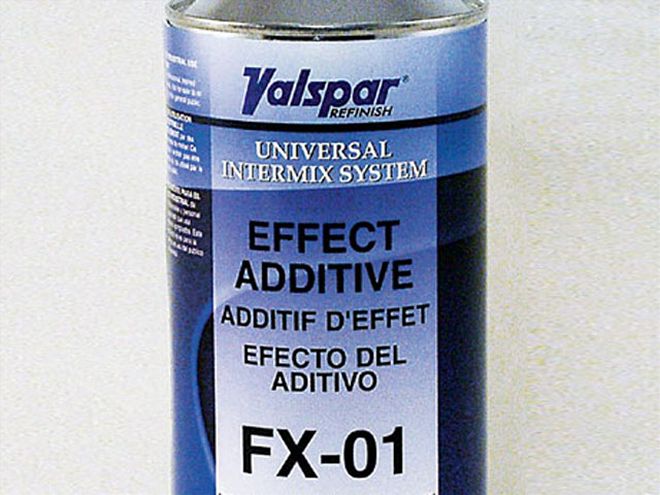 Valspar FX-01 Effect Additive reduces gloss in single-stage paintjobs. This wax-based type of agent generally has the advantage of being more economical than the inert material flatteners, and it's easier to mix.
Valspar FX-01 Effect Additive reduces gloss in single-stage paintjobs. This wax-based type of agent generally has the advantage of being more economical than the inert material flatteners, and it's easier to mix.
The company also offers a Satin Finish Top Coat in 15 different colors, which can be intermixed. It provides an excellent sheen that will retain its color and quality for a long time, even in harsh environments. According to Doug, the epoxy finishes are tough enough that future bodywork can be done right over the paint. Squeeg's Kustoms is also working on an epoxy clear, to be offered in gloss or semigloss finishes, that can be applied directly to bare metal.
Flat In A Flash
A lot of paint specialists, like David Kidd at Planet Color (a division of Sherwin-Williams), don't recommend using primer as a topcoat. A lot of hot rodders will anyway. If you're one of those rodders, Planet Color has a way to make your quick and easy paint project quicker and easier. SpectraPrime primer has been formulated to dry remarkably fast, so you can start sanding it 45 minutes after spraying it. SpectraPrime is available in more than half a dozen different colors, which can be mixed to create all kinds of custom colors. The product dries with low level of gloss, and Sherwin-Williams has a flattening clear that will cut reflectivity while providing a good level of protection. A wet-on-wet sealer, called SpectraSeal, is also available from Planet Color.